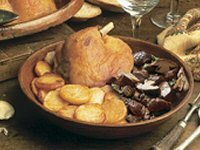Confit de Canard (Duck Confit)
 Confit de Canard (Duck Confit)
Confit de Canard (Duck Confit)
Serves: to serve 4
Prep Time: 1 Hour + waiting
Cook Time: 2 Hours 30 Minutes
Ready In:
3 hrs
30 mins
+ waiting
ingredients
2 -
ducks
- coarse sea salt
- coarse sea salt
directions
- For four people you will need two ducks or, alternatively, if you can get duck legs (with thighs) you can buy four thighs along with about 2lb (1kg) of duck fat. If that sounds strange, it's because, with two whole ducks, you can make more than enough duck fat for this recipe and have lots left over for other uses (you may have noticed that, in many recipes on this site, I use duck fat.)
- No matter which method you use, you need to prepare a day in advance for this recipe (now you know why we buy them ready-made!!). After having removed the duck legs (complete with thighs), coat them thoroughly with coarse sea salt. Place them in a bowl, cover with cling-film and leave them to steep in a cool place (fridge) for 24 hours.
- Meanwhile, to make the duck fat, finely chop or grind the fat off the ducks and place it in a pan. Leave it to melt little by little over a very low heat until all the fat has melted. Pass the fat through a fine sieve (strainer), then use the back of a ladle to press any remaining meat or skin pieces in the sieve (strainer) to extract the fat. You'll end up with plenty of duck fat which you should pour into jars (with lids) and keep it in the fridge until needed (it will keep for months).
1 
Finely chop or grind the fat off the duck 2 
Place the fat in a pan 3 
and leave it to melt over a very low heat 4 
The pieces of fat will melt bit by bit 5 
Until all the fat has melted 6 
Pass it through a fine sieve (strainer) 7 
Use the back of a ladle to press any remaining meat or skin pieces to extract the fat 8 
And you'll end up with plenty of duck fat. Pour it into jars (with lids) and keep it in the fridge until needed (it will keep for months) - The following day, the duck is macerated (softened) and the fat has solidified.
- Remove the duck legs (with thighs) from the fridge and rinse them in fresh water. Wipe them well with kitchen paper to dry them. Place the legs in the bottom of a wide pan along with enough fat to completely cover them when melted. The fat should be just bubbling very gently and slowly - about 70ºC (140ºF)
- Leave the legs to cook gently for 2 - 2½ hours (the cooking should be long but at a low heat and this is one of the very few recipes where a thermometer is recommended).
- If the thighs are small, two hours cooking will be sufficient. If they are large, 2½ hours is better. You can verify that they are very tender by pushing a fork into the flesh. The teeth of the fork should penetrate without resistance.
- Remove the duck and place into a dish until needed. You can pass the fat through a sieve (strainer) again, and keep it in the fridge.
- 15 minutes before needing them, place the duck legs in a large frying pan (skillet) over a low-medium heat and warm them through. After 10 minutes, turn the legs over so the skin side is down and increase the heat until the skin has become golden brown.
- Serve with Sautée Potatoes and Cepes (penny bun or porcino) mushrooms.